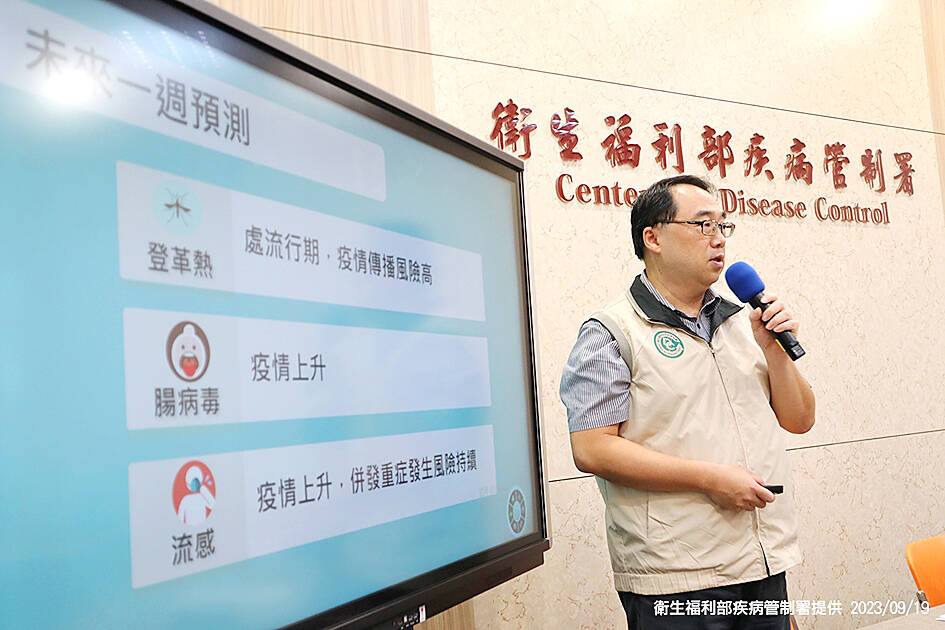Influenza activity is increasing, with more than 100,000 hospital visits for flu-like illness last week, 35 cases of severe flu complications and seven flu-related deaths, the Centers for Disease Control (CDC) said yesterday.
Of the respiratory disease specimens identified at contracted laboratories in the past four weeks, the most common were flu viruses, accounting for 54.8 percent, followed by adenoviruses (16.7 percent) and respiratory syncytial viruses (12.1 percent), CDC Epidemic Intelligence Center Director Guo Hung-wei (郭宏偉) said.
Laboratory monitoring data showed that influenza A strains H3N2 and H1N1 are circulating, with the former accounting for a slightly higher proportion, Guo said.

Photo courtesy of the Centers for Disease Control
About 83 percent of clusters of upper respiratory infection reported last week were in schools, he said, adding that 54 clusters were reported in schools.
There were 102,087 hospital visits for flu-like illness reported last week and the weekly number has been increasing for the past four weeks, he said.
Thirty-five cases of severe flu complications were reported last week, he added.
Among the 35 cases, three were children under the age of 10, including a one-year-old girl who developed flu-like symptoms and a week later had seizures and fell unconscious, CDC physician Lin Yung-ching (林詠青) said.
Doctors suspected that the girl had encephalitis, Lin said, adding that she recovered after being hospitalized for a week.
A six-year-old boy developed altered consciousness, an unstable gait, pneumonia and encephalitis, but his condition improved after treatment, Lin said, adding that the child remained in hospital for observation.
An eight-year-old girl developed flu-like symptoms and weakness of the lower limbs, with encephalitis suspected, he said, adding that she recovered after hospitalization.
People should watch for signs of encephalitis, including neurological complications such as sleepiness or lethargy, altered levels of consciousness, lower limb weakness and seizures, he said.
They should seek medical attention as quickly as possible, as acute necrotizing encephalopathy can progress rapidly, leading to death, he added.
The seven flu-related deaths were people aged 50 to 90, all of whom had underlying health conditions, Lin said.
They died of pneumonia one to two weeks after the onset of symptoms, he said.
CDC data showed that from Oct. 1 last year to Monday, there were 699 confirmed cases of severe flu complications, with 452 infected with H1N1 and 81 percent having underlying health conditions.
The data showed that 156 of them died.
Guo said that 2,016 local cases of dengue fever were reported last week, with 1,849 cases in Tainan.
Three deaths from the disease were reported, all people in their 70s, he said.
There were 12,982 hospital visits for enterovirus infections last week, 5 percent higher than the previous week and still above the epidemic threshold, so people should pay attention to transmission risks for children and watch for signs of severe complications after infection, he said.

Chinese Nationalist Party (KMT) Chairman Eric Chu (朱立倫), spokeswoman Yang Chih-yu (楊智伃) and Legislator Hsieh Lung-chieh (謝龍介) would be summoned by police for questioning for leading an illegal assembly on Thursday evening last week, Minister of the Interior Liu Shyh-fang (劉世芳) said today. The three KMT officials led an assembly outside the Taipei City Prosecutors’ Office, a restricted area where public assembly is not allowed, protesting the questioning of several KMT staff and searches of KMT headquarters and offices in a recall petition forgery case. Chu, Yang and Hsieh are all suspected of contravening the Assembly and Parade Act (集會遊行法) by holding

PRAISE: Japanese visitor Takashi Kubota said the Taiwanese temple architecture images showcased in the AI Art Gallery were the most impressive displays he saw Taiwan does not have an official pavilion at the World Expo in Osaka, Japan, because of its diplomatic predicament, but the government-backed Tech World pavilion is drawing interest with its unique recreations of works by Taiwanese artists. The pavilion features an artificial intelligence (AI)-based art gallery showcasing works of famous Taiwanese artists from the Japanese colonial period using innovative technologies. Among its main simulated displays are Eastern gouache paintings by Chen Chin (陳進), Lin Yu-shan (林玉山) and Kuo Hsueh-hu (郭雪湖), who were the three young Taiwanese painters selected for the East Asian Painting exhibition in 1927. Gouache is a water-based

Taiwan would welcome the return of Honduras as a diplomatic ally if its next president decides to make such a move, Minister of Foreign Affairs Lin Chia-lung (林佳龍) said yesterday. “Of course, we would welcome Honduras if they want to restore diplomatic ties with Taiwan after their elections,” Lin said at a meeting of the legislature’s Foreign Affairs and National Defense Committee, when asked to comment on statements made by two of the three Honduran presidential candidates during the presidential campaign in the Central American country. Taiwan is paying close attention to the region as a whole in the wake of a

OFF-TARGET: More than 30,000 participants were expected to take part in the Games next month, but only 6,550 foreign and 19,400 Taiwanese athletes have registered Taipei city councilors yesterday blasted the organizers of next month’s World Masters Games over sudden timetable and venue changes, which they said have caused thousands of participants to back out of the international sporting event, among other organizational issues. They also cited visa delays and political interference by China as reasons many foreign athletes are requesting refunds for the event, to be held from May 17 to 30. Jointly organized by the Taipei and New Taipei City governments, the games have been rocked by numerous controversies since preparations began in 2020. Taipei City Councilor Lin Yen-feng (林延鳳) said yesterday that new measures by